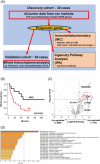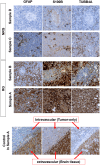Association between microenvironment-related genes and prognosis of primary central nervous system lymphoma
- PMID: 39691244
- PMCID: PMC11647707
- DOI: 10.1002/jha2.1046
Association between microenvironment-related genes and prognosis of primary central nervous system lymphoma
Abstract
Background: Primary central nervous system lymphoma (PCNSL) is a rare lymphoid malignancy. Systemic profiling of the PCNSL tumor microenvironment (TME) was previously conducted through gene expression analysis. We investigated the prognostic impact of TME on survival to establish novel prognostic biomarkers in PCNSL patients.
Methods: We analyzed expression levels of 770 neuroinflammation-related (NFR) genes via NanoString nCounter technology in tumor samples from 30 PCNSL patients. Genes related to the "recurrence group (RG)" or "non-recurrence group (NRG)" were identified and validated using whole transcriptomic analysis of an independent PCNSL cohort (n = 30).
Results: Forty-five of 770 NFR genes were highly expressed in the RG (3-year overall survival (OS, 22.2%), compared with the NRG group (3-year OS 66.7%). Signatures related to glial cells were enriched in the RG-associated gene set. Multivariate analysis revealed that high expressions of TUBB4A (p = 0.028, HR: 3.88), S100B (p = 0.046, HR: 3.093), and SLC6A1 (p = 0.034, HR: 3.765) were significantly related to death. Expression levels of these three genes were also significantly associated with poor OS in the validation cohort. Immunohistochemical staining against TUBB4A, S100B, and proteins specific to glial cells (GFAP, OLIG2, and CD68) revealed significantly higher positivity in RG glial cells.
Conclusion: These data suggest that TME-related genes play a crucial role in the pathogenesis of PCNSL, complementing the well-known involvement of the NF-kB signaling pathway. TME targeting, especially glial cell-specific proteins, may thus open new and complementary avenues of therapy for all stages of PCNSL.
Keywords: Gliosis; Primary central nervous system lymphoma; Tumor microenvironment in central nervous system.
© 2024 The Author(s). eJHaem published by British Society for Haematology and John Wiley & Sons Ltd.
Conflict of interest statement
Lecture honoraria: Eiichi Ishikawa (Daiichi Sankyo, Eisai, Otuka Pharma); Yoshitaka Narita (Ono Pharma) Motoo Nagane (Ono Pharma); Research fund: Sakata‐Yanagimoto Mamiko (Eisai, Bristol Myers Squib, Otuska Pharma, Chugai Pharma), Shigeru Chiba (Thyas, Astellas, Kyowa Kirin); Eiichi Ishikawa (Mitsubishi Electric); Ryo Nishikawa (Ono Pharma) Motoo Nagane (Ono Pharma); Koichi Ichimura (Daiichi Sankyo, Riken Genesis, Gold Ribbon Network, Sumitomo Pharma); Scholarship grant: Shigeru Chiba (Bayer, Eisai, Chugai Pharma, Kyowa Kirin); Eiichi Ishikawa (Eisai) Ryo Nishikawa (Chugai Pharma); Yoshitaka Narita (Ono Pharma, Sumitomo Pharma, Eisai, Taiho Pharma, Ohara Pharma); Motoo Nagane (Chugai Pharma, Bayer, Eisai, Daiichi Sankyo); Endowed chair: Koichi Ichimura (Idorsia Pharmaceuticals).
Figures





References
-
- Hattori K, Sakata‐Yanagimoto M, Okoshi Y, Goshima Y, Yanagimoto S, Nakamoto‐Matsubara R, et al. MYD88 (L265P) mutation is associated with an unfavourable outcome of primary central nervous system lymphoma. Brit J Haematol. 2017;177(3):492–494. - PubMed
-
- Nakamura T, Tateishi K, Niwa T, Matsushita Y, Tamura K, Kinoshita M, et al. Recurrent mutations of CD79B and MYD88 are the hallmark of primary central nervous system lymphomas. Neuropathol Appl Neurobiol. 2016;42(3):279–290. - PubMed
LinkOut - more resources
Full Text Sources
Miscellaneous
